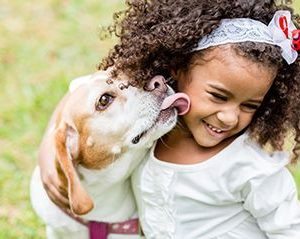- Navigating Your Midlife Crisis: Embracing New Possibilities
- City Raccoons Showing Signs of Domestication
- Mapping the Exposome: Science Broadens Focus to Environmental Disease Triggers
- One Week Less on Social Media Linked to Better Mental Health
- Your Brain Changes in Stages as You Age, Study Finds
- Some Suicide Victims Show No Typical Warning Signs, Study Finds
- ByHeart Formula Faces Lawsuits After Babies Sickened With Botulism
- Switch to Vegan Diet Could Cut Your Greenhouse Gas Emissions in Half
- Regular Bedtime Does Wonders for Blood Pressure
- Dining Alone Could Mean Worse Nutrition for Seniors
Dogs and Kids Are ‘In Sync,’ Study Shows

It is an image as heartwarming as any: Young children giggling as the family dog climbs all over them and licks their faces. But new research suggests the bond may be more than playful.
“The great news is that this study suggests dogs are paying a lot of attention to the kids that they live with,” said study author Monique Udell, an animal behaviorist and associate professor at Oregon State University. “They are responsive to them and, in many cases, behaving in synchrony with them, indicators of positive affiliation and a foundation for building strong bonds.”
Indeed, dogs may even help children with social development, increasing physical activity, managing anxiety or providing attachment as family structures change, the researchers said.
The study recruited 30 youths aged 8 to 17, along with their family dog. About 83% of the kids and adolescents had a developmental disability.
The children were asked to walk with their off-leash dogs in a standardized way among color-coded taped lines in a large empty room. Researchers videotaped the experiments, analyzing how much time each child and their dog were moving or stationary at the same time (what they called activity synchrony), how often they were within 3 feet of each other (proximity), and going in the same direction (orientation).
The dogs were synchronized with the children at higher rates than expected by chance: about 60% of the total time; 73% of the time when moving; and 41% of the time when stationary. They were in close proximity of each other 27% of the time and moving in the same direction 33.5% of the time.
“What we are finding is that kids are very capable of training dogs, and that dogs are paying attention to the kids and can learn from them,” Udell said in a university news release.
“Sometimes we don’t give children and dogs enough credit. Our research suggests that with some guidance we can provide important and positive learning experiences for our kids and our dogs starting at a much earlier age, something that can make a world of difference to the lives of both,” she said.
Still, the percentages were all lower than found in previous research with adults — who had nearly 82% active synchrony and almost 73% proximity with their dogs.
“One interesting thing we have observed is that dogs are matching their child’s behavior less frequently than what we have seen between dogs and adult caretakers, which suggests that while they may view children as social companions, there are also some differences that we need to understand better,” Udell said.
The researchers are now studying more about synchrony and bond quality between dogs and the kids and adults in their families. This includes participation in animal-assisted interventions and increasing the child’s responsibility for the dog’s care.
The findings were published recently in the journal Animal Cognition.
More information
The American Kennel Club shares information on how dogs and humans help each other be healthier and happier.
SOURCE: Oregon State University, news release, Feb. 21, 2021
Source: HealthDay
Copyright © 2025 HealthDay. All rights reserved.










